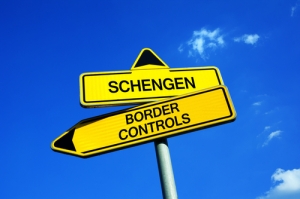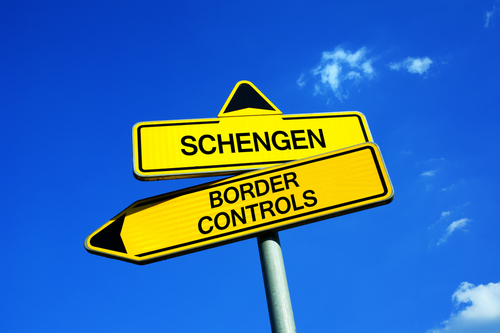Written by Costica Dumbrava,

Free movement across internal borders is one of the EU’s most important achievements, with important benefits for EU citizens. The Schengen Borders Code (or Schengen Code) specifies the conditions under which Member States can introduce temporary checks at their internal borders in cases of serious threats to public policy or internal security. The Code was revised in 2017 in order to strengthen the EU’s external borders and to help cope with unprecedented migratory pressure and cross-border security threats. A Commission legislative proposal to further update the Schengen Code in order to tighten up the rules on temporary border controls is currently with the co-legislators. The recent coronavirus outbreak has pushed several Member States to reintroduce border controls at some of the EU’s internal borders in an attempt to contain the spread of the virus.
The Schengen Code
The Schengen Code lays down the common rules governing the management of internal and external EU borders, including rules and procedures concerning the exceptional introduction of border checks at internal borders. There are currently three cases in which Member States can introduce temporary border checks at their internal borders on grounds of a serious threat to public policy or internal security: (1) in the case of a foreseeable threat (e.g. a special event such as a sporting competition); (2) in the case of an immediate threat; and (3) in the situation of persistent serious deficiencies relating to external borders.
Foreseeable threat to public policy or internal security
According to Article 25 of the Schengen Code, a Member State can reintroduce exceptional border controls at all or specific parts of its internal borders if there is a serious threat to public policy or internal security. Any such measures should be exceptional, temporary and proportionate. If the serious threat to public policy or internal security in the Member State concerned persists, the period can be prolonged by renewable periods of 30 days, up to a maximum six months. The Member State concerned must notify the Commission and the other Member States at least four weeks before taking action, unless the circumstances giving rise to the measures arise within a shorter timeframe. The notification must specify the reasons, scope and duration of the measures. The information must also be submitted to the European Parliament and the Council. The Commission is supposed to issue an opinion after consulting the other Member States.
Immediate threat to public policy or internal security
Under Article 28 of the Code, a Member State can introduce immediate border controls at internal borders if there is a serious threat to public policy or internal security. This measure must be exceptional and is to be limited to up to ten days. If the serious threat to public policy or internal security persists, the period may be prolonged by renewable periods of 20 days, up to maximum of two months. The Member State concerned must notify the Commission and the other Member States immediately, providing information about the reasons, scope and duration of the measures. The Commission must inform the European Parliament immediately and, after consulting the other Member States, should issue an opinion.
Persistent serious deficiencies relating to external border control
Under Article 29 of the Code, a Member State may introduce temporary border checks at internal borders when there are persistent serious deficiencies in the external border management of a Member State, as demonstrated during a Schengen evaluation. This period could be prolonged up to three times if the exceptional circumstances persist, up to a limit of maximum two years. Acting on a proposal from the Commission, the Council can issue a recommendation for one or more Member States to reintroduce border controls at all or specific parts of their borders. The Member State(s) concerned must then notify the other Member States, the European Parliament and the Commission before reintroducing border controls, or inform the Commission in writing of their reasons for not implementing the Council’s recommendation. The Commission must present the European Parliament and the Council with a report on the functioning of the area without internal border controls at least once a year. This report must include a list of all decisions taken to reintroduce border controls at internal borders during the relevant year.
Cases of border checks reinstated at internal borders
The unprecedented inflow of migrants and asylum-seekers that peaked in 2015 put great strain on the EU’s external borders, leading a number of Members States to reintroduce controls along some of their borders with other Member States. While justified by the need to cope with an exceptional situation, these measures have disrupted the functioning of the Schengen area, generating significant economic, social and political costs. According to an EPRS study from 2016, the economic cost for a two-year suspension of Schengen by all participating states would range from €25 billion to €50 billion, while indefinite suspension of Schengen would cost between €100 billion and €230 billion over 10 years. Currently there are six Schengen Member States that have temporarily reintroduced border controls along parts of their borders with other Member States in connection with foreseeable threats to public policy or internal security (mainly terrorism threats, secondary movements by irregular migrants and special events).
Following the outbreak of the coronavirus (COVID-19), a number of Member States have adopted exceptional measures aimed at containing the spreadof the virus, including measures to reintroduce border checks or close their borders with other Member States. To prevent disruption of the supply of essential goods and medical staff in the EU, the European Commission has adopted an export authorisation scheme for protective equipment and has presented Member States with guidelines on border measures.
Norway (12 November 2019 – 12 May 2020)
Sweden (12 November 2019 – 12 May 2020)
Denmark (12 November 2019 – 12 May 2020)
Germany (12 November 2019 – 12 May 2020)
Austria (12 November 2019 – 12 May 2020)
France (31 October 2019 – 30 April 2020)
Revision of the Schengen Code
The Schengen Code was revised in 2017 in the context of measures to strengthen external borders to allow for mandatory systematic checks on all people crossing the EU’s external borders, including the verification of biometric information in the relevant databases.
In September 2017, the Commission presented a proposal for a regulation to amend the rules applicable to the temporary reintroduction of checks at internal borders, aiming to adapt the maximum periods for these measures in order to enable Member States to respond adequately to serious threats to public policy or internal security. The proposal also introduces further procedural safeguards (e.g. an obligation to conduct ‘assessments’) to ensure that the use of internal border checks remains exceptional and proportionate, thus encouraging Member States to use police checks and cooperation instead of internal border controls.
European Parliament position
The European Parliament has constantly reiterated its commitment to safeguarding the Schengen area. In its resolution of 30 May 2018 on the annual report on the functioning of the Schengen area, it condemned ‘the continued reintroduction of internal border checks as this undermines the basic principles of the Schengen area’, and called for the establishment of substantial procedural safeguards, in particular to maintain a strict time limit on the reintroduction of checks at internal borders.
In its legislative resolution on the proposal for a regulation amending the rules applicable to the temporary reintroduction of border control, adopted in April 2019, Parliament reiterated that the Schengen area is one of the Union’s main achievements and stressed the need for a common response to situations seriously affecting the public policy or internal security of the Schengen area. Parliament maintained that the temporary reintroduction of border controls at internal borders should occur only in exceptional circumstances and as a last resort. While it agreed with the Commission that in the event of a long-term threat there should be a possibility to prolong internal border controls beyond six months, on an exceptional basis, the European Parliament maintained that the prolongation must not lead to a further extension of temporary border controls beyond one year (the Commission proposed a two-year maximum). Having adopted its position at first reading, Parliament is now waiting for Council to set out its position.
Read this ‘At a glance’ on ‘Temporary border controls in the Schengen area‘ in the Think Tank pages of the European Parliament.








[…] Source Article from https://epthinktank.eu/2020/03/17/temporary-border-controls-in-the-schengen-area/ […]